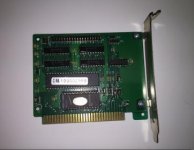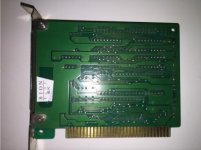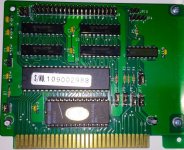Upcoming Events:
- VCF South West - June 14 - 16, Davidson-Gundy Alumni Center at University of Texas at Dallas
- VCF West - Aug 2 - 3, Computer History Museum, Mountain View, CA
- VCF Midwest - Sept 7 - 8 2024, Schaumburg, IL
- VCF SoCal - Mid February 2025, Location TBD, Southern CA
- VCF East - April 2025, Infoage Museum, Wall NJ
-
Please review our updated Terms and Rules here
- Forums
- Companies
- IBM Computers, PCs, Clones and Descendants
- PCs and Clones (XT and early AT class machines)
You are using an out of date browser. It may not display this or other websites correctly.
You should upgrade or use an alternative browser.
You should upgrade or use an alternative browser.
Help identify possible XT IDE card and uses
- Thread starter Maxheap
- Start date
You can check with CheckIt or PCCONFIG if that BIOS is seen in upper memory area
and read what the card is described.
On the card you should find jumpers used for setting BIOS address
(maybe these 4 on the right-down corner).
You can use them to locate the BIOS of the card in free space in upper memory.
and read what the card is described.
On the card you should find jumpers used for setting BIOS address
(maybe these 4 on the right-down corner).
You can use them to locate the BIOS of the card in free space in upper memory.
Maxheap
Member
modem7
10k Member
A bigger photo (so that we can see what the chips are) will help.
Seems very likely.I'm assuming its an XT IDE controller?
vwestlife
Veteran Member
It's probably IDE-XT, as in the 8-bit variant of IDE used by the Tandy 1000 series, Olivetti Prodest PC1, and some other XT clones in the late '80s and early '90s... not to be confused with the XT-IDE, which is a card designed to allow use of (semi-) modern 16-bit IDE-AT / Parallel ATA drives in vintage XT-class machines.
SomeGuy
Veteran Member
Perhaps dumping the BIOS chip would yield more information. (And Modem7 might want to add the BIOS to his site)
Chuck(G)
25k Member
It's probably IDE-XT, as in the 8-bit variant of IDE used by the Tandy 1000 series, Olivetti Prodest PC1, and some other XT clones in the late '80s and early '90s... not to be confused with the XT-IDE, which is a card designed to allow use of (semi-) modern 16-bit IDE-AT / Parallel ATA drives in vintage XT-class machines.
The drive type is also sometimes referred to as "XTA" as opposed to the usual 16-bit "ATA".
Cimonvg
Experienced Member
hello
looks like my card - see post : www.vintage-computer.com/vcforum/showthread.php?15819-VTI-XTB-IDE-card/page2
..my card works with Conner CP3000.
/cimonvg
looks like my card - see post : www.vintage-computer.com/vcforum/showthread.php?15819-VTI-XTB-IDE-card/page2
..my card works with Conner CP3000.
/cimonvg
Maxheap
Member
hello
looks like my card - see post : www.vintage-computer.com/vcforum/showthread.php?15819-VTI-XTB-IDE-card/page2
..my card works with Conner CP3000.
/cimonvg
hi,
Yeah it does look identical. Is that Conner drive an IDE drive? Also, any idea on what each of the jumpers is for?
modem7
10k Member
Yes, I can add it to http://www.minuszerodegrees.net/rom/rom.htm(And Modem7 might want to add the BIOS to his site)
However, without the make and model of the card known, I will need a photo (so that people know what exactly the ROM image is from).
The photo at post #1 is too small.
Cimonvg
Experienced Member
hello
when searched the Conner CP3000 it states it is a "IDE /AT".
I think i did try a bigger disk on the controller - without any good result..
Perhaps the controller only supports disks not bigger then 40 mb ?!
/cimonvg
when searched the Conner CP3000 it states it is a "IDE /AT".
I think i did try a bigger disk on the controller - without any good result..
Perhaps the controller only supports disks not bigger then 40 mb ?!
/cimonvg
Maxheap
Member
Yes, I can add it to http://www.minuszerodegrees.net/rom/rom.htm
However, without the make and model of the card known, I will need a photo (so that people know what exactly the ROM image is from).
The photo at post #1 is too small.
Here's a little bit better pic. The upload keeps shrinking them, so let me know if you want a close up on just the ROM or anything else.
Attachments
Maxheap
Member
hello
when searched the Conner CP3000 it states it is a "IDE /AT".
I think i did try a bigger disk on the controller - without any good result..
Perhaps the controller only supports disks not bigger then 40 mb ?!
/cimonvg
I have a 40mb Maxtor. Can I have a pic of your jumpers or was the previous pic how its setup now?
Maxheap
Member
I actually got this working by copying the jumpers off a screen shot of Cimonvgs card with the Maxtor 40mb IDE. From the format routine, looks like it supports several larger IDE drives.
modem7
10k Member
looks like my card - see post : www.vintage-computer.com/vcforum/showthread.php?15819-VTI-XTB-IDE-card/page2
Yes, I can add it to http://www.minuszerodegrees.net/rom/rom.htm
However, without the make and model of the card known, I will need a photo (so that people know what exactly the ROM image is from).
The photo at post #1 is too small.
I have the photo, and the one that Cimonvg made, 'ready to roll'. [here]Here's a little bit better pic. The upload keeps shrinking them, so let me know if you want a close up on just the ROM or anything else.
All I need now is a file copy of the ROM. Do either of you know how to create one?
modem7
10k Member
The preferred way of getting a ROM image is via an EPROM programmer. That is because sometimes, the content of the ROM is different to how the PC 'sees' it. An example is the ROM in an IBM EGA card. If someone created a ROM image file by using a program (such as DEBUG), and then used that file (unmodified) to make a replacement ROM, that replacement ROM would not work in an IBM EGA card.If you send me directions I'll grab it for you.
But in most cases, the PC 'sees' the ROM contents exactly as it is laid out in the ROM.
The ROM in your IDE card is socketed, and you are asking for instructions. That tells me that you do not have an EPROM programmer. So, we will have to use a program.
The ROM in almost all XT-class hard disk controllers starts at address C8000, so we will assume that (for now at least). Your ROM is 32KB sized (a 27C256).
So use DEBUG in the following way to create the 32KB sized image file (named MYROM.BIN), and then email the file to me at temp6432836@outlook.com.au
C:\>DEBUG
-N MYROM.BIN
-R BX
BX 0000
:0000
-R CX
CX 0000
:8000
-M C800:0 8000 0100
-W 0100
Writing 8000 bytes
-Q
C:\>
BTW:
An alternate program is Mike Brutman's PCJRCART program. It creates a file for each ROM extension that it finds. Use it with the -noheaders option. Available from [here]. This will be unsuitable if the author of the ROM has incorrectly specified the ROM size at the third byte.



